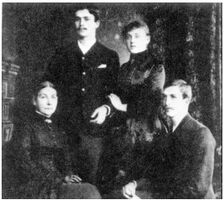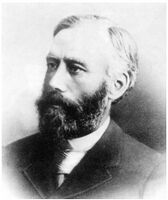248
FROM THE POLAR LANDS
Just a year ago, during the Christmas holidays, a numerous society had gathered in the country house, or rather the old hereditary castle, of a wealthy landowner in Finland. Many were the remains in it of our forefathers’ hospitable way of living; and many the medieval customs preserved, founded on traditions and superstitions, semi-Finnish and semi-Russian, the latter imported into it by its female proprietors from the shores of the Neva. Christmas trees were being prepared and implements for divination were being made ready. For, in that old castle there were grim worm-eaten portraits of famous ancestors and knights and ladies, old deserted turrets, with bastions and Gothic windows; mysterious somber alleys, and dark and endless cellars, easily transformed into subterranean passages and caves, ghostly prison cells, haunted by the restless phantoms of the heroes of local legends. In short, the old Manor offered every commodity for romantic horrors. But alas! this once they serve for nought; in the present narrative these dear old horrors play no such part as they otherwise might.
Its chief hero is a very commonplace, prosaical man—let us call him Erkler. Yes; Dr. Erkler, professor of medicine, half-German through his father, a full-blown Russian on his mother’s side and by education; and one who looked a rather heavily built, and ordinary mortal. Nevertheless, very extraordinary things happened with him.
Erkler, as it turned out was a great traveler, who by his own choice had accompanied one of the most famous explorers on his journeys round the world. More than once 249they had both seen death face to face from sunstrokes under the Tropics, from cold in the Polar Regions. All this notwithstanding, the doctor spoke with a never-abating enthusiasm about their “winterings” in Greenland and Novaya Zemla, and about the desert plains in Australia, where he lunched off a kangaroo and dined off an emu, and almost perished of thirst during the passage through a waterless track, which it took them forty hours to cross.
“Yes,” he used to remark, “I have experienced almost everything, save what you would describe as supernatural. . . . This, of course if we throw out of account a certain extraordinary event in my life—a man I met, of whom I will tell you just now—and its . . . indeed, rather strange, I may add quite inexplicable, results.”
There was a loud demand that he should explain himself; and the doctor, forced to yield, began his narrative.
“In 1878 we were compelled to winter on the northwestern coast of Spitzbergen. We had been attempting to find our way during the short summer to the pole; but as usual, the attempt had proved a failure, owing to the icebergs, and, after several such fruitless endeavors, we had to give it up. No sooner had we settled than the polar night descended upon us, our steamers got wedged in and frozen between the blocks of ice in the Gulf of Mussel, and we found ourselves cut off for eight long months from the rest of the living world. . . . I confess I, for one, felt it terribly at first. We became especially discouraged when one stormy night the snow hurricane scattered a mass of materials prepared for our winter buildings, and deprived us of over forty deer from our herd. Starvation in prospect is no incentive to good humor; and with the deer we had lost the best plat de résistance against polar frosts, human organisms demanding in that climate an increase of heating and solid food. However, we were finally reconciled to our loss, and even got accustomed to the local and in reality more nutritious food—seals, and seal-grease. Our men from the remnants of our lumber built a house neatly divided into two compartments, one for three professors and myself, and the other for themselves; and, a few wooden sheds being 250constructed for meteorological, astronomical and magnetic purposes, we even added a protecting stable for the few remaining deer. And then began the monotonous series of dawnless nights and days, hardly distinguishable one from the other, except through dark-gray shadows. At times, the “blues” we got into were fearful! We had contemplated sending two of our three steamers home in September, but the premature and unforseen formation of ice walls round them had thwarted our plans; and now, with the entire crews on our hands, we had to economize still more with our meager provisions, fuel and light. Lamps were used only for scientific purposes: the rest of the time we had to content ourselves with God’s light—the moon and the Aurora Borealis. . . . But how describe these glorious, incomparable northern lights! Rings, arrows, gigantic conflagrations of accurately divided rays of the most vivid and varied colors. The November moonlight nights were as gorgeous. The play of moonbeams on the snow and the frozen rocks was most striking. These were fairy nights.
“Well, one such night—it may have been one such day, for all I know, as from the end of November to about the middle of March we had no twilights at all, to distinguish the one from the other—we suddenly espied in the play of colored beams, which were then throwing a golden rosy hue on the snow plains, a dark moving spot. . . . It grew, and seemed to scatter as it approached nearer to us. What did this mean? . . . It looked like a herd of cattle, or a group of living men, trotting over the snowy wilderness. . . . But animals there were white like everything else. What then was this? . . . human beings? . . .
“We could not believe our eyes. Yes, a group of men was approaching our dwelling. It turned out to be about fifty seal-hunters, guided by Matiliss, a well-known veteran mariner, from Norway. They had been caught by the icebergs, just as we had been.
“‘How did you know that we were here?’ we asked.
“‘Old Johan, this very same old party, showed us the way’—they answered, pointing to a venerable-looking old man with snow-white locks.
251 “In sober truth, it would have beseemed their guide far better to have sat at home over his fire than to have been seal-hunting in polar lands with younger men. And we told them so, still wondering how he came to learn of our presence in this kingdom of white bears. At this Matiliss and his companions smiled, assuring us that ‘old Johan’ knew all. They remarked that we must be novices in polar borderlands, since we were ignorant of Johan’s personality and could still wonder at anything said of him.
“‘It is nigh forty-five years,’ said the chief hunter, ‘that I have been catching seals in the Polar Seas, and as far as my personal remembrance goes, I have always known him, and just as he is now, an old, white-bearded man. And so far back as in the days when I used to go to sea, as a small boy with my father, my dad used to tell me the same of old Johan, and he added that his own father and grandfather too, had known Johan in their days of boyhood, none of them having ever seen him otherwise than white as our snows. And, as our forefathers nicknamed him “the white-haired all-knower,” thus do we, the seal hunters, call him, to this day.’
“‘Would you make us believe he is two hundred years old?’—we laughed.
“Some of our sailors crowding round the white-haired phenomenon, plied him with questions.
“‘Grandfather! answer us, how old are you?’
“‘I really do not know it myself, sonnies. I live as long as God has decreed me to. As to my years, I never counted them.’
“‘And how did you know, grandfather, that we were wintering in this place?’
“‘God guided me. How I learned it I do not know; save that I knew—I knew it.’”
252 [In Lucifer, Vol. XI, October, 1892, pp. 97-105, the Editors published, with no Editorial explanation of any kind, an essay by H.P.B. entitled “Life and Death: A Conversation between a Great Eastern Teacher, H.P.B., Colonel Olcott, and an Indian.” Upon closer examination, this proved to be an English translation—possibly by H. P. B. herself, though unlikely of certain portions of her Russian serial story known as “From the Caves and Jungles of Hindostan.” The Russian original text of these passages can be found in the Russkiy Vestnik (Russian Messenger), Vol. CLXXXI, February, 1886, pp. 802-13. (See the 1975 Adyar edition of From the Caves and Jungles of Hindostan.)
It was not the first time that this material, translated into English, had appeared in print. It was published—this time possibly translated by H.P.B. herself—in Lucifer, Vol. III, January 1889, as “Dialogue on the Mysteries of the After-Life,” with the addition of a few passages. The entire material of this “Dialogue” was used by H. P. B. in The Key to Theosophy, pp. 117-121, and 156-171.
In August, September and October, 1893, the Editors of Lucifer published three installments of what appeared to be an essay from the pen of H.P.B. on the subject of “Elementals.” These appeared in Vols. XII and XIII of Lucifer. Close analysis has shown this material to be merely a compilation of Isis Unveiled, with the addition of a few new passages. These will be found in Vol. VI of the present Series, between March and April, 1884, with all available data concerning them and the reasons why this material has been shifted to an earlier period.
In Vol. XV of Lucifer (September and October, 1894, pp. 9-17 and 97-104, respectively), the Editors published two installments of H.P.B.’s Essay entitled “Tibetan Teachings.” As appears from its first paragraph, this Essay must have been written much earlier; it has been shifted to the end of the year 1883, with an explanatory note giving all necessary particulars, and may be found in Volume VI of the present Series.
In Vol. XVIII, No. 106, of Lucifer, under date of June 15th 1896, the following Editorial remarks appear on p. 265:
“Readers of Lucifer will rejoice to see an article under the loved and familiar name of H. P. Blavatsky. In the course of preparing the third volume of The Secret Doctrine for the press, a few manuscripts were found mixed with it that form no part of the work itself, and these will be published in her


253
old magazine. Next month the article from her pen will be a criticism of the line taken by Hargrave Jennings and others touching the phallic element in religions, and will be entitled. “Christianity, Buddhism and Phallicism.’”
The Editors then proceed to publish an article entitled “‘Spirits’ of Various Kinds.” This material is on the whole identical with H.P.B.’s essay entitled “Thoughts on the Elementals,” which appeared in May, 1890 (Lucifer, Vol. VI, pp. 177-88). It will be found, therefore, in its rightful chronological place in Vol. XII, pages 187-205 of the present Series, with the addition of a few brief passages as they appeared in this later reprint.—Compiler.]
